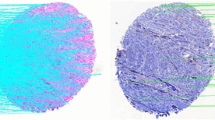Abstract
A rigorous accuracy analysis is given to various techniques for estimating parameters of geometric models from noisy data. First, it is pointed out that parameter estimation for vision applications is very different in nature from traditional statistical analysis and hence a different mathematical framework is necessary. After a general framework is formulated, typical numerical techniques are selected, and their accuracy is evaluated up to high order terms. As a byproduct, our analysis leads to a “hyperaccurate” method that outperforms existing methods.
Similar content being viewed by others
References
Akaike, H. (1977). A new look at the statistical model identification. IEEE Transactions on Automatic Control, 16(6), 716–723.
Amari, S., & Kawanabe, M. (1997). Information geometry of estimating functions in semiparametric statistical models. Bernoulli, 3, 29–54.
Begelfor, E., & Werman, M. (2005). How to put probabilities on homographies. IEEE Transactions on Pattern Analysis and Machine Intelligence, 27(10), 1666–1670.
Bickel, P. J., Klassen, C. A. J., Ritov, Y., & Wellner, J. A. (1994). Efficient and adaptive estimation for semiparametric models. Baltimore: Johns Hopkins University Press.
Bookstein, F. L. (1979). Fitting conic sections to scattered data. Computer Graphics and Image Processing, 9(1), 56–71.
Chernov, N., & Lesort, C. (2004). Statistical efficiency of curve fitting algorithms. Computational Statistics and Data Analysis, 47(4), 713–728.
Chojnacki, W., Brooks, M. J., van den Hengel, A., & Gawley, D. (2000). On the fitting of surfaces to data with covariances. IEEE Transactions on Pattern Analysis and Machine Intelligence, 22(11), 1294–1303.
Chojnacki, W., Brooks, M. J., & van den Hengel, A. (2001). Rationalising the renormalisation method of Kanatani. Journal of Mathematical Imaging and Vision, 14(1), 21–38.
Chojnacki, W., Brooks, M. J., van den Hengel, A., & Gawley, D. (2004). From FNS to HEIV: A link between two vision parameter estimation methods. IEEE Transactions on Pattern Analysis and Machine Intelligence, 26(2), 264–268.
Chojnacki, W., Brooks, M. J., van den Hengel, A., & Gawley, D. (2005). FNS, CFNS and HEIV: A unifying approach. Journal of Mathematical Imaging and Vision, 23(2), 175–183.
Hartley, R., & Zisserman, A. (2000). Multiple view geometry in computer vision. Cambridge: Cambridge University Press.
Kanatani, K. (1993). Renormalization for unbiased estimation. In Proceedings of the 4th international conference on computer vision (pp. 599–606), Berlin, Germany, May 1993.
Kanatani, K. (1996). Statistical optimization for geometric computation: theory and practice. Amsterdam: Elsevier. Reprinted by Dover, New York (2005).
Kanatani, K. (1998). Cramer–Rao lower bounds for curve fitting. Graphical Models and Image Processing, 60(2), 93–99.
Kanatani, K. (2004). Uncertainty modeling and model selection for geometric inference. IEEE Transactions on Pattern Analysis and Machine Intelligence, 26(10), 1307–1319.
Kanatani, K. (2005). Further improving geometric fitting. In Proceedings of the 5th international conference on 3D digital imaging and modeling (pp. 2–13), Ottawa, Canada, June 2005.
Kanatani, K. (2006). Ellipse fitting with hyperaccuracy. IEICE Transactions on Information and Systems, E89-D(10), 2653–2660.
Kanatani, K., & Ohta, N. (2003). Comparing optimal three-dimensional reconstruction for finite motion and optical flow. Journal of Electronic Imaging, 12(3), 478–488.
Kanatani, K., & Sugaya, Y. (2000). High accuracy fundamental matrix computation and its performance evaluation. IEICE Transactions on Information and Systems, E90-D(2), 579–585.
Kanatani, K., & Sugaya, Y. (2007). Performance evaluation of iterative geometric fitting algorithms. Computational Statistics and Data Analysis, 52(2), 1208–1222.
Kanatani, K., Ohta, N., & Kanazawa, Y. (2000). Optimal homography computation with a reliability measure. IEICE Transactions on Info and Systems, E83-D(7), 1369–1374.
Leedan, Y., & Meer, P. (2000). Heteroscedastic regression in computer vision: Problems with bilinear constraint. International Journal of Computer Vision, 37(2), 127–150.
Neyman, J., & Scott, E. L. (1948). Consistent estimates based on partially consistent observations. Econometrica, 16(1), 1–32.
Ohta, N. (2003). Motion parameter estimation from optical flow without nuisance parameters. In 3rd international workshop on statistical and computational theory of vision, Nice, France, October 2003. http://www.stat.ucla.edu/~sczhu/Workshops/SCTV2003.html.
Okatani, T., & Deguchi, K. (2003). Toward a statistically optimal method for estimating geometric relations from noisy data: Cases of linear relations, In Proceedings of the IEEE conference on computer vision and pattern recognition (Vol. 1, pp. 432–439), Madison, WI, USA, June 2003.
Pennec, X., Fillard, P., & Ayache, N. (2006). A Riemannian framework for tensor computing. International Journal of Computer Vision, 66(1), 41–66.
Rissanen, J. (1989). Stochastic complexity in statistical inquiry. Singapore: World Scientific.
Sampson, P. D. (1982). Fitting conic sections to “very scattered” data: An iterative refinement of the Bookstein algorithms. Computer Graphics and Image Processing, 18(1), 97–108.
Taubin, G. (1991). Estimation of planar curves, surfaces, and non-planar space curves defined by implicit equations with applications to edge and range image segmentation. IEEE Transactions on Pattern Analysis and Machine Intelligence, 13(11), 1115–1138.
Author information
Authors and Affiliations
Corresponding author
Rights and permissions
About this article
Cite this article
Kanatani, K. Statistical Optimization for Geometric Fitting: Theoretical Accuracy Bound and High Order Error Analysis. Int J Comput Vis 80, 167–188 (2008). https://doi.org/10.1007/s11263-007-0098-0
Received:
Accepted:
Published:
Issue Date:
DOI: https://doi.org/10.1007/s11263-007-0098-0




